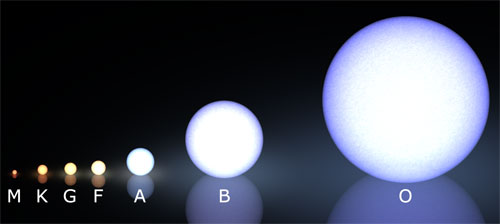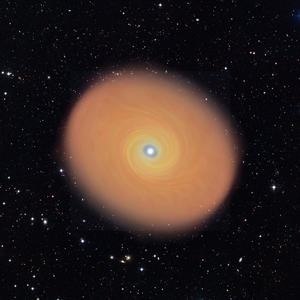High-mass stars may outshine and outweigh the Sun, but observations show all stars may have had a similar beginning.

There’s a reason astronomers call the Sun a dwarf. Though about 1,000 Jupiters could fit inside our star, it’s a tame pipsqueak compared with the rare and massive O and B stars that end their lives in fantastic supernova explosions. Recent evidence, though, shows that all stars may form in much the same way. Despite their divergent ends, could it be that such different stars claim the same provenance?
That question has proven difficult to answer. Astronomers have long known that low-mass stars form stepwise: a cloud collapses into clumps, clumps collapse into cores, then cores collapse into disks that each feed their own central protostar. But massive stars have kept their origin stories a secret: they’re rare, far away, and form so quickly that they’re born still swaddled in the dust and gas that smaller stars shed.
Now, new observations from the Atacama Large Millimeter/submillimeter Array (ALMA) and Atacama Pathfinder Experiment (APEX) in Chile have enabled astronomers to peer through a cocoon and see a stable disk of gas feeding the forming O-star at its center. Katharine Johnston (University of Leeds, UK) and colleagues published their results in the November 1st Astrophysical Journal.
A Massive Star with a Disk

K.G. Johnston and ESO (background image)
Johnston’s team observed a protostar, dubbed AFGL 4176, with ALMA at wavelengths around 1.2 millimeters. Though the star-to-be lies 14,000 light-years away, 36 of ALMA’s antennas separated by up to 1.2 kilometers captured the system at 0.3-arcsecond resolution.
The sharp, long-wavelength images pierce the dust cocoon and reveal the motions of gas swirling in a disk that feeds the central protostar. The disk spans somewhere between 760 and 980 times the Earth-Sun distance — several times the size of our own solar system.
Lower-resolution observations with APEX also show outflows shooting out from both sides of the structure. Since accretion disks of all kinds, whether around stars or black holes, generally sport jets or winds, this observation supports the disk scenario.
Other Stars & Other "Disks"
This find isn’t totally unprecedented, says Andrés Guzmán (University of Chile and Harvard-Smithsonian Center for Astrophysics). For example, in 2014 Guzmán led a team that found a rotating structure around the future O star G345.4938+01.4677. But this structure might not be a "real" disk — that is, a stable object whose physics is managed by the massive protostar at its center. It might instead be a gravitationally unstable donut-shaped mass that could perhaps even collapse to form a second star in orbit around the first.
Other observations, such as that of Álvaro Sánchez-Monge (then at Astrophysical Observatory of Arcetri, Italy) and colleagues, found a more stable structure around the future B-type star G35.20+0.74N.
However, Guzmán says, the new observations from Johnston's team are “better and more clear in many ways,” thanks in part to improvements on ALMA, including the addition of antennas and the ability to separate antennas by longer distances.
“High-mass stars are becoming more and more clearly associated with disks,” Guzmán adds. “Now we need to determine whether these disks play the same role in high-mass star formation as in low-mass protostars.” In other words, do massive stars grow from their disks in the same way as their smaller brethren? Will planets around massive stars form in the same way as well? With ALMA only growing in its millimeter-observing power, astronomers may soon answer these questions.
Read Sky & Telescope’s October 2015 issue for more on the ongoing debate surrounding massive star formation.
 5
5









Comments
Jim-Baughman
November 20, 2015 at 7:30 pm
It would have been really nice to see some of ALMA’s images of this developing star, rather than an artist’s conception. Are ALMA’s pictures available?
You must be logged in to post a comment.
Monica YoungPost Author
November 23, 2015 at 3:13 pm
Hi Jim, the problem with images per se is that they are still rather blobby for these kinds of observations, due to the target (a forming massive star) and the wavelength (around 1 mm). The really informative plot is not an image at all, but a position-velocity plot. Though it's far from intuitive, this plot shows the rotation of the disk around the forming star. That's Figure 4 in the linked paper.
You must be logged in to post a comment.
William-Perkins
November 21, 2015 at 10:05 am
Please see pointer to the article below. Artist's conception definitely more user-friendly.
http://arxiv.org/pdf/1509.08469v1.pdf
Best
You must be logged in to post a comment.
Rick-Littleton
November 22, 2015 at 2:59 am
Being an amatuer amatuer, I am confused. Why is it a mystery that more massive stars collapse more quickly. It would seem consistent with gravitational theory that more massive amounts of matter (primordial clouds) would exert greater contraction-by-gravity force than moderate stars, and so would go through the collapse process at a faster rate. What am I missing?
You must be logged in to post a comment.
Monica YoungPost Author
November 22, 2015 at 9:30 pm
Hi Rick, It's not so much that the quick formation is a surprise (your point's valid), but that quick formation makes seeing the early stages of star formation process more difficult, since the star is shrouded in dust and gas even after it "turns on".
You must be logged in to post a comment.
You must be logged in to post a comment.